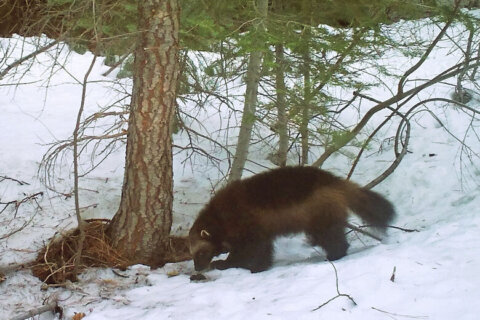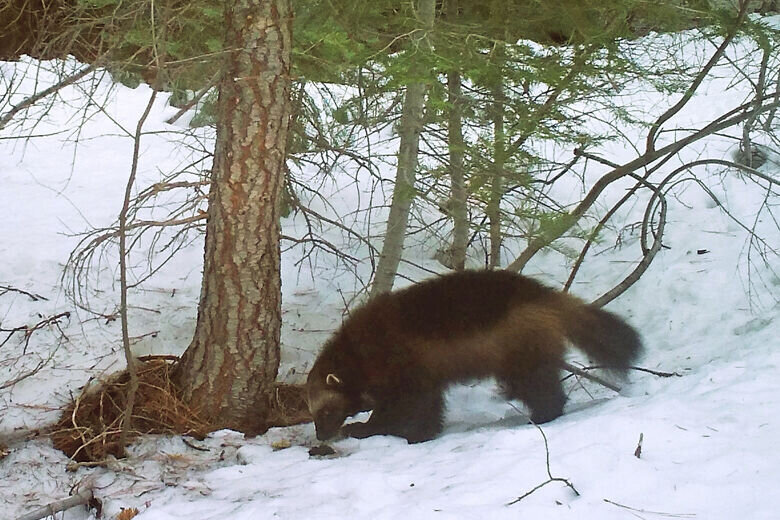
BILLINGS, Mont. (AP) — The North American wolverine will receive long-delayed threatened species protections under a Biden administration proposal released Wednesday in response to scientists’ warnings that climate change will likely melt away the rare species’ snowy mountain refuges and push them toward extinction.
Across most of the U.S., wolverines were wiped out by the early 1900s from unregulated trapping and poisoning campaigns. About 300 surviving animals in the contiguous U.S. live in fragmented, isolated groups at high elevations in the northern Rocky Mountains.
Wolverines join a growing number of animals, plants and insects — from polar bears in Alaska to crocodiles in southern Florida — that officials say are at growing risk as increasing temperatures bake the planet, altering snowfall patterns and raising sea levels.
In the coming decades, warming temperatures are expected to shrink the mountain snowpack wolverines rely on to dig dens where they birth and raise their young.
The decision Wednesday by the U.S. Fish and Wildlife Service follows more than two decades of disputes over the risks of climate change, and threats to the long-term survival of the elusive species. Officials wrote in the proposal that protections under the Endangered Species Act were needed “due primarily to the ongoing and increasing impacts of climate change and associated habitat degradation and fragmentation.”
The animals resemble small bears and are the world’s largest species of terrestrial weasels. Sometimes called “mountain devils,” they thrive in harsh alpine environments.
Protections were rejected under former President Donald Trump. A federal judge in 2022 ordered the administration of President Joe Biden to make a final decision this week on whether to seek protections.
Protecting the wolverines’ remaining habitat strongholds gives the animals a fighting chance, said former U.S. Forest Service research biologist Jeffrey Copeland.
Listing wolverines as threatened “means that we have not paid enough attention to this critter to give it what it needs,” he said.
“It’s a failure. But in this type of situation, it’s the only tool that we have.”
Republican lawmakers in Montana had urged the administration to delay its decision, claiming the scientists’ estimates were too inaccurate to make a fair call about the dangers faced by wolverines. The lawmakers, led by hard-right conservative Rep. Matt Rosendale, warned that protections could lead to future restrictions on activities allowed in wolverine habitats, including snowmobiling and skiing.
Rosendale said Wednesday that he would seek to revoke threatened species status for wolverines at the earliest chance if it’s finalized.
“Whether it’s private property, state property or federal property, if we are limited on the use of that land based upon this status, that’s a taking,” he said. “Is the federal government going to compensate the state for lack of use on state-owned lands? …. I don’t think so.”
In September, government scientists conceded some uncertainty about how quickly mountain snowpacks could disappear every spring in areas with wolverines. They also said habitat loss due to climate change — combined with other problems such as increased development including houses and roads — will likely harm wolverine populations.
Habitat loss as a result of climate change and other stressors will likely “impact the viability of wolverines in the contiguous U.S. through the remainder of this century,” they concluded.
Fish and Wildlife Service officials said in documents released Wednesday that they were “not concerned” about the effects of existing developments such as ski resorts since wolverines likely already avoid those areas. But winter recreation could hurt wolverines in the future, they said, as activities like backcountry skiing and snowmobiling have become more popular in some areas.
The scientists added that some of those losses could be offset if wolverines are able to recolonize areas such as California’s Sierra Nevada and Colorado’s Rocky Mountains.
Environmentalists have argued in multiple lawsuits against the Fish and Wildlife Service that wolverines face localized extinction from climate change, habitat fragmentation and low genetic diversity.
The proposal to protect them “gives the wolverine a fighting chance for survival,” said Timothy Preso, an attorney for the group Earthjustice who’s been part of that legal effort.
Another attorney said he had concerns that trapping would be allowed to continue for other species in areas where wolverines live. The Fish and Wildlife Service proposal would allow some accidental killing of wolverines as long as trappers report any captures within five days and use “best practices” to avoid the animals.
“I’m not sure that’s possible. Wolverines are scavengers — they go everywhere and eat everything,” said Matt Bishop with the Western Environmental Law Center.
Wolverine populations live in remote areas of Montana, Wyoming, Idaho and Washington state.
In recent years, individual animals have been documented in California, Utah, Colorado and Oregon. However, there’s been “no evidence” that the animals are becoming established and breeding in those states, officials said in Wednesday’s proposal.
The wildlife service received a petition to protect wolverines in 2000 and the agency recommended protections in 2010. President Barack Obama’s administration proposed protections and later sought to withdraw them but was blocked by a federal judge who said in 2016 that the snow-dependent animals were “squarely in the path of climate change.”
Protections were rejected in 2020 under Trump, based on research suggesting populations were expanding, not contracting. Federal wildlife officials at the time predicted enough snow would persist at high elevations for wolverines to den in mountain snowfields each spring.
They reversed course in a revised analysis published in September that said wolverines were “less secure than we described.”
The animals require expansive wildlands, with home ranges for adult wolverines covering as much as 610 square miles (1,580 square kilometers), according to one study.
They also need protection from trapping, according to scientists. Wolverine populations in southwestern Canada plummeted by more than 40% over the past two decades due to overharvesting by trappers, which could have effects across the U.S. border, scientists said.
Wolverine trapping was once legal in states including Montana.
At least 10 wolverines have been accidentally captured in Montana since trapping was restricted in 2012. Three were killed and the others released unharmed. In Idaho, trappers have accidentally captured 11 wolverines since 1995, killing three.
Copyright © 2024 The Associated Press. All rights reserved. This material may not be published, broadcast, written or redistributed.







